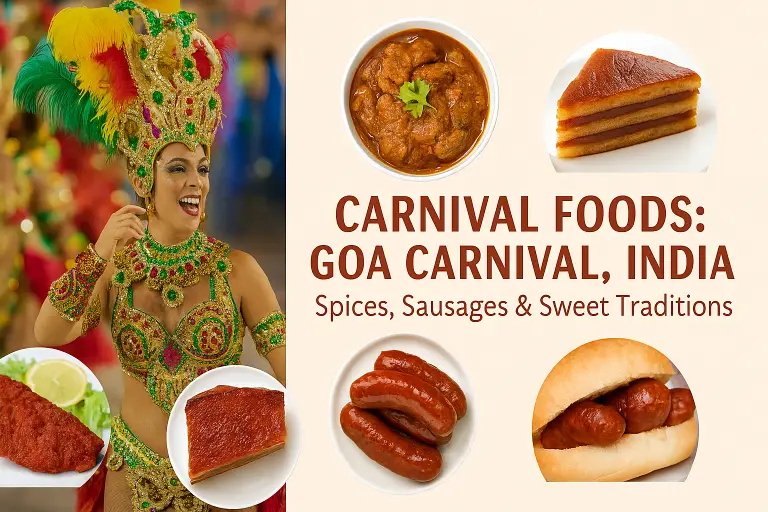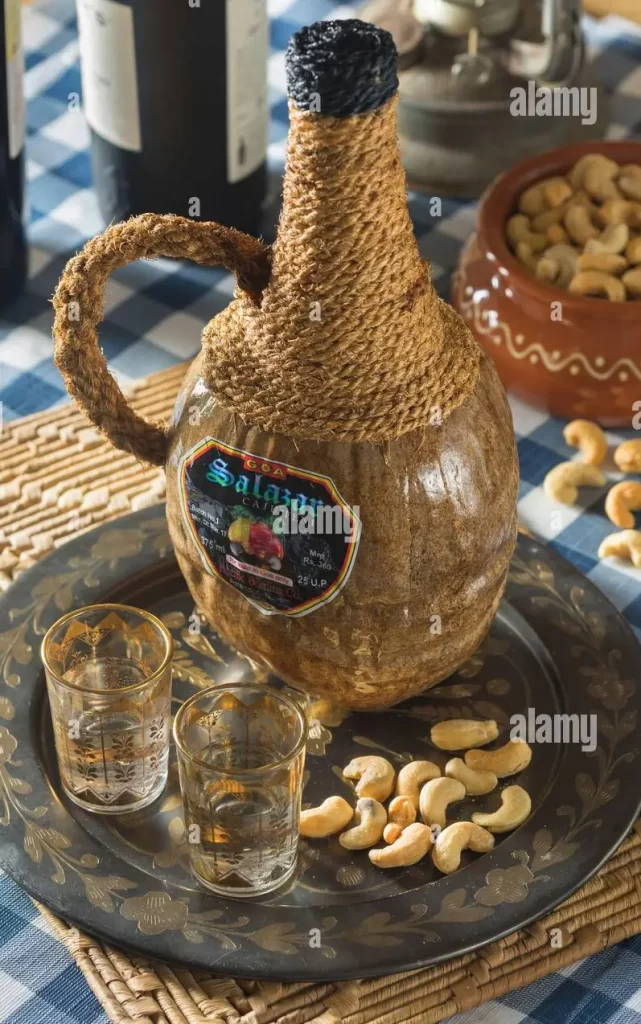- Carnival Foods: Rio Carnival, Brazil
- Carnival foods: Notting Hill Carnival, London
- Carnival Foods: Mardi Gras, New Orleans, USA
- Carnival Foods: Goa Carnival Foods – Spices, Sausages & Sweet Traditions of Indo-Portuguese
Carnivals are celebration of life, within the society of a particular place or group of people. In fact most of the carnivals are annual or seasonal in nature, but has the yearlong effect on culture, art, economy and sociology. And, religion, tradition, spirituality, cultural root and humanity play a major role behind the carnivals. But one thing that we often neglect to give focus, is – food. Rather to say, Carnival foods.
Foods, as well as beverages are an integral part of life; no doubt, it will be more than filler in any carnival. Let us have some appetizing view of Carnival Foods.
Goa Carnival Foods – Spices, Sausages & Sweet Traditions of Indo-Portuguese
Every year in late February, the coastal paradise of Goa transforms into a celebration of joy, music, dance, and food. The Goa Carnival — also known as “Intruz” — dates back to the Portuguese colonial era and is one of India’s most unique pre-Lenten festivals. While Goa is famous for its beaches and nightlife, the Carnival brings out a different flavor — one steeped in heritage, theatricality, and culinary richness of Goa Carnival Foods.

A Timeless Tradition: The Story of Goa Carnival
The Goa Carnival is more than just a lively celebration — it’s a cultural legacy that has stood the test of time. First introduced by the Portuguese in the 1700s, the carnival began as a pre-Lenten festival, meant for indulgence before the 40 days of Lent — a Christian period of fasting, reflection, and restraint in preparation for Easter.
Traditionally, Lent called for simplicity and sacrifice, with people abstaining from rich foods and festivities. That’s why grand celebrations like the Goa Carnival emerged — to feast and make merry before the solemn weeks began.
Unlike many European carnivals that faded with time, Goa’s version has not only survived but thrived — even after Portuguese rule ended in 1961. Though it saw a dip in popularity for some years, a strong revival in the late 20th century transformed it into the grand, inclusive street festival we see today.
A Culinary Journey Through Goa Carnival Food
Unlike other carnivals around the world that lean on sugar-dusted treats or flamboyant cocktails, Goa Carnival’s culinary identity is grounded in savory, spice-heavy, and soulful dishes — a true fusion of Indian and Portuguese culinary traditions.

Let’s take a walk through the bustling streets of Panaji and Mapusa during Carnival week and discover what’s cooking in Goa Carnival Foods.
1. Bebinca – The Queen of Goan Desserts
Layered with care and often reserved for festive occasions, bebinca is a rich, baked pudding made with coconut milk, egg yolks, sugar, and ghee. Traditionally baked one layer at a time over a slow fire, it can take hours to prepare. During Carnival, bakeries and home kitchens alike serve slices of this indulgent dessert. The golden brown layers symbolize patience and festivity — a sweet finale to every spicy meal but the sweetest part of Goa Carnival food.
2. Pork Vindaloo – A Colonial Classic
A dish born from the Portuguese vinha d’alhos (wine and garlic marinade), the Goan Vindaloo evolved into a fiery curry packed with red chilies, garlic, cumin, vinegar, and tender pork. Served hot with poi (Goan bread) or rice, it’s a festive must-have as Goa carnival food. During Carnival, food stalls often serve a milder version to appeal to tourists, but the locals still savor its traditional bold heat.
3. Sorpotel – The Celebration Stew
This dish takes time — and love. Sorpotel is made using finely diced pork, including liver and heart, which is then cooked in vinegar, garlic, and spices. It’s left to rest and mature, with flavors intensifying each day. Often eaten with sanna (steamed rice cakes), sorpotel is a favorite goa carnival food during Carnival buffets and Sunday feasts.
4. Goan Sausages (Chouriço Pão) – Street Food Hero
Nothing says street food like a sizzling sausage stuffed in warm bread. Goan chouriço, spiced with garlic, chili, and vinegar, is sold at Carnival stalls grilled over charcoal fires. Locals grab them with poi or buns — crisp outside, juicy inside. The smoky aroma alone is enough to lead you to the right stall.

5. Rechado Fish Fry – Coastal Carnival Flavor
Fresh seafood is a staple of Goan cuisine, and during the Carnival, kingfish, mackerel, and pomfret are marinated in a red chili rechado masala (meaning “stuffed”) and shallow-fried to crispy perfection. Often served with onion rings and lime, this dish brings the coast to your plate.
6. Feni with Limca – Goa’s Iconic Drink
No carnival food experience is complete without a refreshing local drink. Enter Feni — a strong spirit distilled from cashew apples or coconut sap. During Carnival, it’s often enjoyed in a cooler, lighter mix with Limca (Indian lime soda), mint, and ice. This local favorite packs a punch and pairs beautifully with spicy carnival fare.
💡 Note: Feni is potent — savor it slowly while enjoying the festive performances and floats!
The Story Behind the Food
What makes Goa Carnival foods so special is their layered cultural identity. The Portuguese colonizers brought pork, vinegar-based cooking, and baked desserts, while the local population added heat, fermentation, and bold spices. During Carnival, Christian Goans prepare these dishes as part of festive feasts before Lent, while street vendors offer quick bites for tourists and revelers.
Goa Carnival Foods are not just about flavor — it’s about celebrating cultural harmony on every plate.
🧐 Did You Know? Carnival Curiosities
- 🎭 Once Exclusive: The carnival was initially reserved for the Portuguese elite, featuring luxurious masquerade balls and private feasts.
- 🍳 Messy Merrymaking: Early celebrations included playful — and chaotic — traditions like throwing flour, eggs, and even vegetables at each other, which have now morphed into friendly water fights.
- 🎶 Saved by Artists: After Goa’s liberation, the festival nearly vanished — but local musicians, performers, and cultural groups brought it back to life.
- 👑 Meet King Momo: Inspired by Brazil’s carnival, King Momo, the festival’s symbolic ruler, now leads the parades and declares the days of revelry open.
- 🌈 Secular Spirit: Unlike many Indian festivals, the Goa Carnival isn’t rooted in religion — it celebrates life, culture, and community in a way that’s uniquely Goan.
Final Thoughts
From the first sip of Feni to the last bite of Bebinca, the Goa Carnival offers a food journey like no other — rich with spice, soul, and sunshine. It’s a celebration not only of pre-Lenten revelry but of culinary storytelling passed down through generations.
So if you find yourself under a sky full of confetti in Goa, follow the rhythm, follow the color — but most of all, follow the aroma of Goa Carnival Foods.
It’s not Food Carnival! It’s Carnival Food!!


Comments are closed, but trackbacks and pingbacks are open.